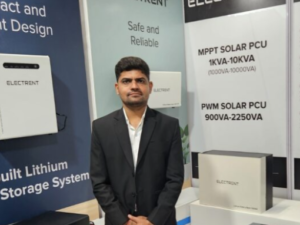
By Chirag Chawla, Founder & CEO, Electrent Energy
India’s journey toward energy self-reliance is gaining momentum, with lithium-based technologies playing a pivotal role. Frequent power outages, voltage fluctuations, and growing electricity demand have highlighted the need for reliable backup systems across both homes and commercial spaces. As a result, lithium-ion batteries are increasingly being adopted for their efficiency, durability, and compatibility with clean energy sources.
While traditionally associated with electric vehicles, lithium batteries are now making inroads into residential and commercial power storage—offering an alternative to conventional lead-acid systems. This transition supports broader national goals of sustainability, energy independence, and local innovation.
The Shift from Traditional to Modern Backup Systems
Lead-acid batteries have long been the standard for inverter-based power backup in Indian households and businesses. However, they come with several limitations—shorter lifespan, larger size and weight, slower charging times, and regular maintenance requirements.
In contrast, lithium-ion batteries offer:
• Longer life cycles
• Higher energy density, resulting in smaller and lighter systems
• Faster charging capabilities
• Better thermal stability and overall safety
• Greater efficiency, with charge-discharge rates more than 95%
For homes, these advantages mean less space is needed for backup systems, and appliances can run longer during outages. In commercial environments, this translates to reduced downtime, lower maintenance, and improved operational reliability.
Market Trends and Growing Demand
India’s demand for lithium-ion batteries is growing at a rapid pace. According to market research, the domestic lithium-ion battery market was valued at $5.78 billion in 2025, and it is projected to exceed $16 billion by 2030, expanding at a compound annual growth rate (CAGR) of over 22%.
While the electric vehicle (EV) sector is a major consumer, the stationary energy storage segment which includes inverter backup systems for homes and businesses is also expanding. Increasing awareness, unreliable grid conditions, and the popularity of solar power are driving this growth in non-automotive applications.
Another forecast suggests that by 2030, India’s total lithium-ion battery demand could reach 115 GWh, with around 14% CAGR projected for stationary use cases. This includes power backup in residences, offices, shops, hospitals, and small-scale industries.
Policy Support and Domestic Manufacturing
India’s government has introduced several initiatives to boost domestic battery production and reduce dependence on imports. Among them, the Production-Linked Incentive (PLI) Scheme stands out as a key driver, incentivizing large-scale manufacturing of advanced chemistry cells, including lithium-ion batteries.
In addition to incentives, the government has also rationalized import duties on battery components and supported the development of battery parks and R&D facilities. These steps are expected to reduce production costs, increase availability, and improve supply chain resilience over time.
Cost and Accessibility
One of the biggest concerns about lithium-ion technology has been its cost. However, prices have dropped significantly in recent years due to technological improvements, economies of scale, and increased competition.
Today, lithium battery backup systems cost nearly the same as lead-acid batteries, and in some cases, even less while still offering a far lower total cost of ownership This is due to:
• Reduced maintenance
• Longer product life
• Higher efficiency
• Lower replacement frequency
As domestic manufacturing scales up and competition increases, lithium-based solutions are becoming more accessible to both urban and rural users. Households benefit from consistent lighting and appliance use, while businesses gain more dependable operational continuity.
Environmental Benefits and Recycling Efforts
In addition to reliability and efficiency, lithium technology supports India’s environmental goals. These batteries:
• Do not contain toxic metals like lead or cadmium
• Are more energy-efficient, reducing greenhouse gas emissions
• Have smaller environmental footprints due to longer lifespan and compact design
Furthermore, battery recycling is an emerging area of focus. Recycling not only helps recover valuable materials like lithium, cobalt, and nickel but also reduces the environmental impact of battery disposal.
Industry experts estimate that India’s lithium-ion battery recycling market could quadruple by 2030, supported by government policies and industry partnerships. These developments could reduce raw material imports and enhance India’s resource independence.
Integration with Renewable Energy
Lithium batteries are highly compatible with solar energy systems. Across India, more homes and commercial units are installing rooftop solar panels paired with lithium storage. This integration allows users to store solar power during the day and use it during power cuts or at night.
Such systems not only reduce electricity bills but also lessen dependence on the central grid, contributing to national renewable energy targets. Moreover, in regions with frequent outages or no grid access, solar-plus-storage setups offer an efficient alternative to diesel generators.
Challenges Ahead
Despite promising growth, the lithium battery sector in India still faces several challenges:
• Limited domestic reserves of lithium mean raw materials must be imported.
• High upfront costs may deter low-income users.
• Recycling infrastructure, while growing, is still in its early stages.
Addressing these issues will require continued investment, policy clarity, and innovation. Public-private collaborations, research into alternative battery chemistries, and improvements in collection and recycling logistics will be crucial in overcoming these hurdles.
Lithium battery technology is steadily transforming how power is stored and used in India. From homes to businesses, these systems are helping address longstanding issues related to power reliability, cost, and sustainability.
As India strives to become more energy independent, lithium-based backup systems—supported by strong policy frameworks, growing local manufacturing, and expanding recycling networks—are expected to play a vital role.
By enabling reliable, cleaner, and smarter energy solutions, lithium technology is not just reshaping the power backup landscape—it is also contributing meaningfully to India’s broader goals of self-reliance and environmental responsibility.